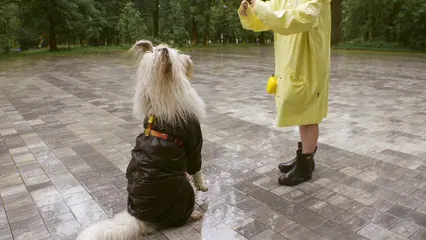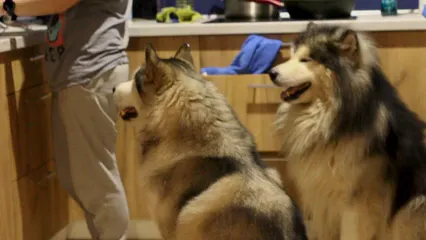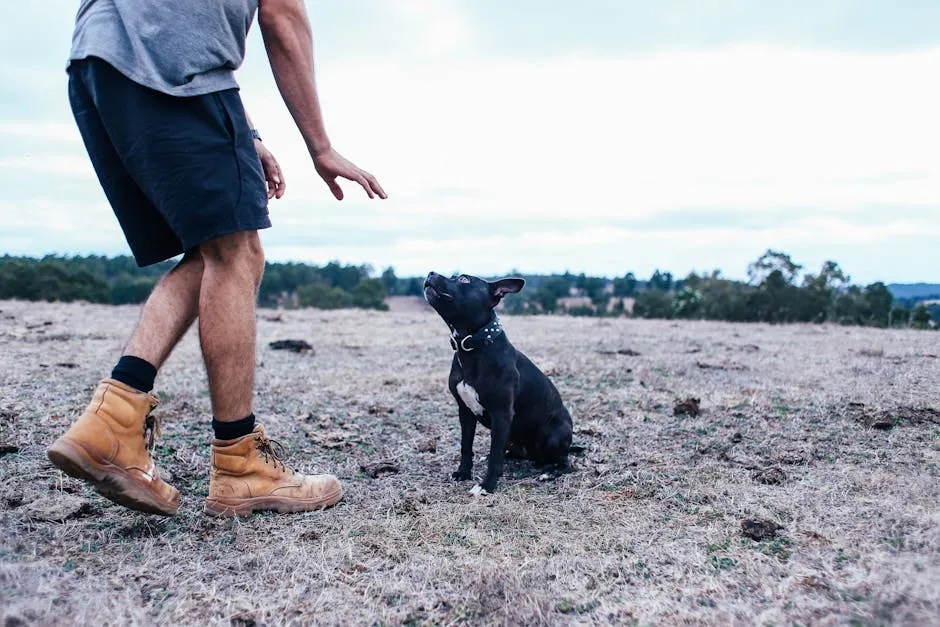Introduction
Therapy dogs are furry superheroes. They don’t wear capes, but they sure know how to bring comfort and joy! These amazing pups visit hospitals, schools, and nursing homes, providing emotional support to those in need. Imagine a child in a hospital bed, feeling scared and alone. Enter the therapy dog, tail wagging, ready to offer a warm cuddle. That’s the magic of therapy dogs!
The recognition of the emotional and psychological benefits these dogs bring is growing. Studies show that interactions with therapy dogs can lower anxiety, reduce stress, and even improve recovery rates in patients. It’s no wonder that therapy dogs are becoming a staple in various facilities. In this post, we’ll take you through the training process, requirements, and the profound benefits of having a therapy dog in our lives.

To help your dog become the best therapy companion, consider investing in a Dog Training Collar with Remote. This handy tool helps reinforce commands with ease, making training sessions a breeze!
Understanding Therapy Dogs
What Is a Therapy Dog?
A therapy dog is a trained canine that provides comfort and affection to people in various settings. These dogs are not the same as service dogs, which assist individuals with specific disabilities. Unlike emotional support animals, therapy dogs require formal training and certification. They visit places like hospitals, schools, and nursing homes, helping individuals deal with emotional or psychological challenges.
Therapy dogs play a vital role in improving mental well-being. They help reduce feelings of loneliness and anxiety, offering a sense of calm in stressful environments. These dogs are trained to interact gently with different people, providing support without judgment. Their ability to brighten someone’s day is simply remarkable. Imagine the joy of a therapy dog visiting an elderly person in a nursing home, bringing smiles and warmth to their heart. That’s the essence of therapy dogs!

If you’re looking to pamper your therapy dog, a cozy Dog Bed for Comfort can make all the difference. A well-rested dog is a happy dog, and a happy dog is a great therapy dog!
Evaluating Your Dog as a Therapy Candidate
When it comes to training your dog as a therapy candidate, not every pup is cut from the same cloth. You need to assess their temperament, behavior, and readiness for the role. After all, your dog will be providing emotional support, so they must shine in various environments.
Key Traits of a Good Therapy Dog
First things first, let’s talk about temperament. A good therapy dog should be calm, friendly, and social. They need to enjoy being around people, even those they’ve never met before. An outgoing nature helps them connect with individuals in hospitals, schools, and nursing homes.
Obedience is a must. Your dog should respond reliably to commands like sit, stay, and come. Tolerance to distractions is also crucial. Imagine a bustling hospital or a noisy classroom; your dog must remain focused and composed. If your pup gets rattled easily, it might be time to work on their confidence and socialization skills.

Enhancing your dog’s training can be fun with the right tools. Consider a Dog Training Clicker. This simple device can make a world of difference in reinforcing positive behaviors during training sessions!
Assessing Your Dog’s Readiness
To evaluate your dog’s readiness, observe their behavior in various settings. Take them to parks, busy streets, or community events. Watch how they react to new people and situations. Do they seek attention and enjoy the interaction? Or do they shy away and seem stressed?
A temperament evaluation can also help. Consider enrolling your dog in socialization classes or joining a local training group. These experiences expose them to different stimuli and people, allowing you to gauge their adaptability. Look for signs of comfort, such as wagging tails, relaxed body language, and a willingness to engage.
In conclusion, selecting the right dog for therapy work is essential. A calm, friendly demeanor combined with obedience and social skills creates an ideal candidate. By observing your dog’s behavior and providing ample socialization experiences, you’ll set them up for success in their new role as a therapy dog.

Training Your Dog for Therapy Work
Basic Obedience Training
Basic obedience is the building block of therapy dog training. Commands like sit, stay, come, and heel create a solid foundation. These commands ensure your dog is well-mannered and responsive. A therapy dog must follow commands reliably in various situations, especially around people who may be anxious or frightened.
Incorporating training into your daily routine is essential. Turn walks into training sessions by practicing commands regularly. For example, ask your dog to sit before crossing the street. Use meal times to practice “stay” while you prepare their food. This not only reinforces their skills but also strengthens your bond.
Even simple activities can become training opportunities. If you have visitors, encourage your dog to greet them politely. This practice helps with socialization and ensures your dog remains calm in new environments.

Advanced Training Techniques
Once your dog masters basic commands, it’s time to advance. Therapy dogs must learn to handle distractions and social interactions. Advanced commands include “visit,” where the dog approaches people for affection, and “lap,” where they sit on a person’s lap. These commands prepare your dog for various therapeutic settings.
Socialization is another vital aspect. Expose your dog to different environments, sounds, and people. This helps them remain calm in busy places like hospitals or schools. Positive experiences with diverse groups of people will enhance their comfort level.
The AKC Canine Good Citizen (CGC) test is an excellent benchmark for therapy dog candidates. Passing the CGC test demonstrates that your dog has mastered basic obedience and can behave well in public settings. Many therapy dog organizations require this certification as a prerequisite.
Consider joining advanced training classes that focus on therapy-specific skills. These classes often simulate real therapy environments, providing your dog with crucial experience. The more prepared they are, the more effective they will be in their future therapy role.

Enroll in Therapy Dog Classes
Seeking professional training can significantly enhance your dog’s skills. Look for classes or organizations specializing in therapy dog training. These programs often cover essential techniques and provide a supportive community for handlers.
Joining a local therapy dog group offers numerous benefits. You’ll meet experienced handlers who can share valuable insights and tips. Plus, you’ll gain access to resources, support, and encouragement throughout your journey.
Many organizations also provide liability insurance, which is essential when volunteering in public spaces. This coverage protects both you and your dog while you bring joy to those in need.
In conclusion, training your dog for therapy work is a rewarding process. With dedication, proper obedience training, advanced skills, and community support, your furry friend will be well on their way to becoming a certified therapy dog. Embrace the journey, and get ready to make a positive impact together!

Certification Process
Step-by-Step Guide for Certification
Testing Requirements
To turn your furry friend into a certified therapy dog, you need to navigate the certification maze. Organizations like the American Kennel Club (AKC) and Therapy Dogs International (TDI) offer specific requirements. First off, your dog must be at least one year old. They need to pass the AKC Canine Good Citizen (CGC) test, which evaluates obedience, manners, and social skills. This test isn’t just a walk in the park; it’s a benchmark for most therapy dog programs.
The CGC test includes essential commands such as sit, stay, and loose leash walking. Your dog must also remain calm in distracting situations, like a toddler zooming by on a tricycle or a cat darting across the room. Remember, no pressure! Each organization has its unique testing standards, so check their websites for details.

Documentation Needed
Now that your dog is ready for the big day, gather the required paperwork. Health records are a must! Your dog needs to be up-to-date on vaccinations, especially rabies. Some organizations might also ask for proof of the CGC certification. A health certificate from your vet is often needed as well, ensuring your pup is happy and healthy for their therapy duties.
Don’t forget to include a recent photo of your adorable companion. After all, they’ll need to look their best for their therapy dog ID badge!
Evaluation Process
What should you expect during the therapy dog evaluation? Picture this: a room filled with other dogs and their handlers. The evaluator will assess your dog’s behavior in various scenarios. They’ll observe how your pup interacts with people and how they react to distractions.
During the evaluation, your dog might encounter mobility aids, like wheelchairs or crutches. They should remain calm and collected. A friendly wagging tail is a plus! Being able to sit or lie down quietly while the evaluator interacts with you is crucial.
Once your dog successfully passes the evaluation, congratulations! You’re one step closer to making a positive impact in the community. The journey doesn’t end here; remember to continue socializing and training your dog to keep their skills sharp.

Becoming a Therapy Dog Handler
Role and Responsibilities of a Handler
Being a therapy dog handler is a rewarding yet responsible role. First and foremost, understand your dog’s limits. Every pup has their comfort zone. If they seem overwhelmed, it’s your job to recognize it and adjust the situation. Keeping your dog comfortable ensures they provide the best support possible.
During visits, maintain your dog’s well-being. This includes monitoring their health and ensuring they have plenty of breaks. Hydration is key! It’s essential to be aware of their stress signals, such as panting or excessive yawning.
Handlers also need to remain calm and approachable. You’re the bridge between your dog and the people you visit. Being friendly and open helps create a positive experience for everyone involved. Plus, your dog will pick up on your energy, so a relaxed handler means a relaxed pup!

Building Connections
As a therapy dog handler, you’ll find that building connections is a vital part of the experience. You’ll engage in conversations with people of all walks of life. This social aspect can be both exciting and nerve-wracking. If small talk isn’t your forte, no worries! Just be genuine and let your dog do the talking.
Communication skills are essential. Not only do you need to chat with people, but you’ll also need to communicate effectively with your dog. Establish a bond based on trust, and your dog will respond beautifully during visits.
Overall, being a therapy dog handler is about creating a team dynamic. Together, you and your dog can spread joy and comfort to those in need. Embrace the role, and enjoy the connections you make along the way!

Common Challenges and Solutions
Training your dog for therapy work is rewarding, but it’s not all sunshine and wagging tails. Challenges can pop up like that squirrel your pup just can’t resist. Let’s tackle some common issues and their solutions to help your therapy dog shine brighter than a freshly polished trophy.
Addressing Behavioral Issues
Every dog has quirks, and therapy dogs are no exception. Common problems include jumping, barking, and not knowing when to settle down. Imagine your dog, all excited, leaping into the lap of a frail elderly person. Yikes! While enthusiasm is adorable, it can be overwhelming.
To curb jumping, teach the “sit” command. Reward your dog for staying seated when meeting new people. Consistency is key! Practice with friends, family, or even at the dog park. Use treats and praise to reinforce calm behavior.
Barking can also be a concern, especially in quiet settings. If your dog barks when excited or anxious, consider desensitizing them to triggers. For example, expose them to sounds they might encounter during visits, like laughter or applause. Use positive reinforcement when they remain calm, teaching them that quiet equals treats.
Lastly, if your dog struggles to settle during visits, work on a “place” command. Encourage them to go to a designated spot, like a mat or blanket, and reward them for staying there. This practice will help them understand that calm behavior is expected in therapy settings.

Preparing for Therapy Visits
Preparation is half the battle. Before visits, set your dog up for success with calming techniques. A little pre-visit exercise can work wonders. Take your dog for a brisk walk or play a game of fetch. This helps release pent-up energy and promotes a more relaxed demeanor during visits.
Calming techniques can also include massages or gentle brushing before heading out. This not only soothes your dog but also strengthens your bond. Additionally, consider using calming products, such as Pheromone Diffuser for Dogs or a Dog Anxiety Wrap, especially if your dog tends to get nervous.
Establish a consistent routine for visits. Familiarity breeds comfort! Arriving at the facility early allows your dog to acclimate to the environment before meeting individuals. This extra time can help alleviate anxiety and ensure your dog feels ready to spread joy.
In summary, while challenges arise, addressing behavioral issues and preparing adequately for therapy visits can pave the way for success. With patience and practice, your dog will be a therapy superstar, bringing comfort and joy to everyone they meet!

Conclusion
Therapy dogs are more than just pets; they are vital companions that enhance the lives of others. Through their training journey, they not only learn valuable skills but also discover the joy of helping people. The bond formed between a therapy dog and their handler is truly special, filled with love and shared experiences.
Training your dog for therapy work can be a fulfilling path. Both the dog and the people they serve benefit immensely. So, if you’ve considered this rewarding journey, take the leap! Your furry friend could become a beacon of hope and comfort in someone’s life.
FAQs
Can any dog become a therapy dog?
Not every dog is cut out for therapy work. Key traits include a friendly demeanor and calm temperament. Size or breed doesn’t matter as much as personality. Dogs should enjoy being around people and tolerate handling from strangers.
What is the difference between therapy dogs and service dogs?
Therapy dogs offer emotional support to many people in various settings. They work alongside handlers and do not have the same public access rights as service dogs, which assist individuals with specific disabilities.
Do therapy dogs need to be certified?
Certification is essential for therapy dogs. It verifies that your dog has the necessary skills and temperament for therapy work. Many organizations offer certification programs to ensure dogs are well-prepared.
How long does it take to train a therapy dog?
Training timelines vary. Generally, it takes several months to a year to prepare your dog, depending on their prior training and experience. Consistency and practice are crucial for success.
What types of facilities can therapy dogs visit?
Therapy dogs can visit various locations, including hospitals, schools, nursing homes, and even disaster sites. The interactions can range from providing comfort to participating in structured activities, depending on the setting.
Please let us know what you think about our content by leaving a comment down below!
Thank you for reading till here 🙂
Also, don’t forget to keep your dog hydrated during those therapy visits! A Portable Water Bottle for Dogs is a must-have for those on-the-go moments!

Lastly, if your dog loves to chew, you might want to stock up on some Dog Chew Toys. They can keep your furry friend entertained while you prepare for their therapy sessions!
All images from Pexels





